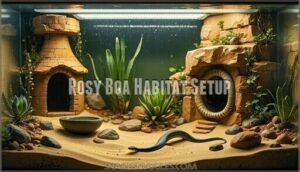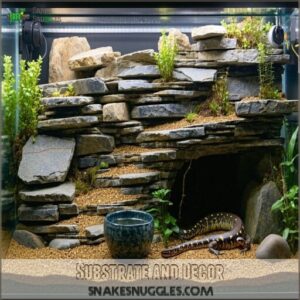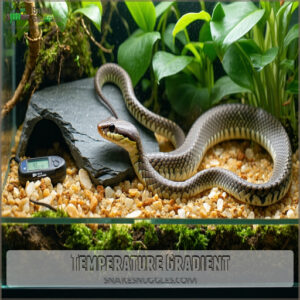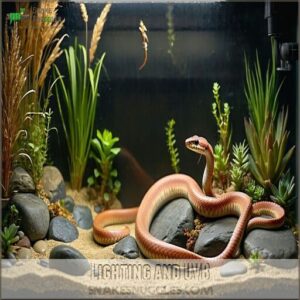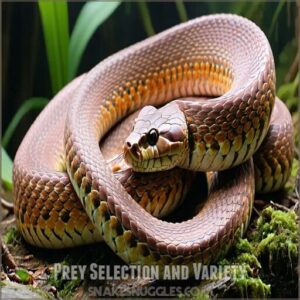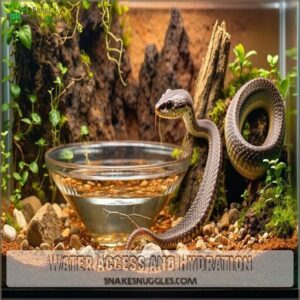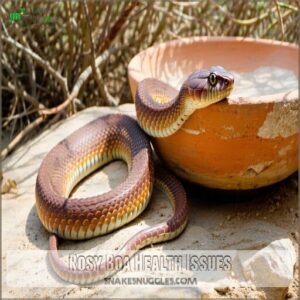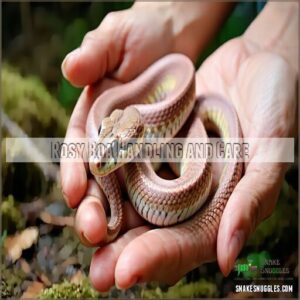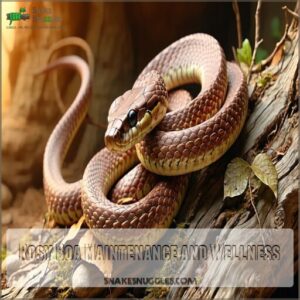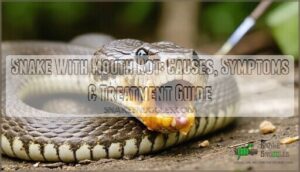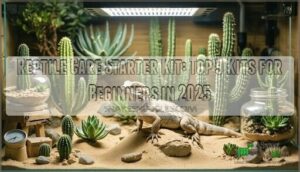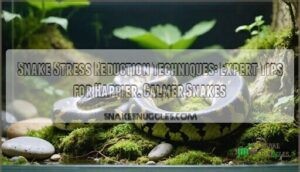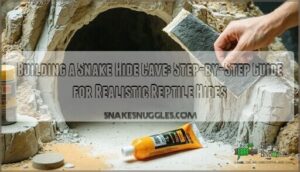This site is supported by our readers. We may earn a commission, at no cost to you, if you purchase through links.
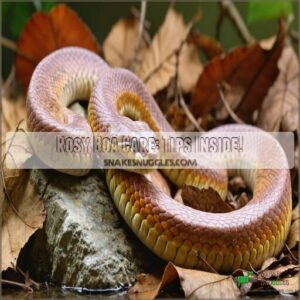 You’ll want to provide a 20-gallon tank with a temperature gradient of 65-90°F for your rosy boa.
You’ll want to provide a 20-gallon tank with a temperature gradient of 65-90°F for your rosy boa.
Use a secure lid, good ventilation, and a suitable substrate like aspen or paper towels.
Feed your rosy boa frozen-thawed rodents, and handle them gently, supporting their body.
Regular veterinary visits and proper sanitation are important.
By following these rosy boa care tips, you’ll be well on your way to creating a happy and healthy environment for your pet, and there’s more to learn about keeping your rosy boa thriving.
Table Of Contents
- Key Takeaways
- Rosy Boa Habitat Setup
- Rosy Boa Diet and Feeding
- Rosy Boa Health Issues
- Rosy Boa Handling and Care
- Rosy Boa Maintenance and Wellness
- Frequently Asked Questions (FAQs)
- How much humidity does a rosy boa need?
- How to care for Rosy and Sand Boas as pet snakes?
- How often should you feed a rosy boa?
- How long should a rosy boa enclosure be?
- Are rosy boas easy to take care of?
- Does a rosy boa need a heat lamp?
- What size tank does a rosy boa need?
- Can a rosy boa live in a 10 gallon tank?
- Where does the Rosy Boa live in the wild?
- Do rosy boa need a heat lamp?
- Conclusion
Key Takeaways
- You’ll want to provide a 20-gallon tank with a temperature gradient of 65-90°F and a suitable substrate like aspen or paper towels to create a comfortable environment for your rosy boa.
- You should feed your rosy boa frozen-thawed rodents, with hatchlings eating weekly and adults eating every 10-14 days, matching prey size to the snake’s thickest body part to ensure a balanced diet.
- You’ll need to maintain a humidity level below 50%, ideally between 20-40%, and provide a shallow water bowl, changed daily, to prevent respiratory issues and keep your rosy boa hydrated.
- You should handle your rosy boa gently, supporting its body fully, and limit initial handling sessions to 5-10 minutes to help build trust and minimize stress, making sure to wash your hands before and after handling to prevent disease transmission.
Rosy Boa Habitat Setup
You’re about to set up a habitat for your Rosy Boa, and it’s necessary to get it right.
You’ll need to create an enclosure that mimics their natural desert environment, with the right size, substrate, temperature, and lighting to keep your pet happy and healthy, ensuring a natural environment.
Enclosure Size and Type
You’ll need a 20-gallon tank or enclosure measuring 30" x 12" x 12" for your rosy boa.
Make sure secure lids and good ventilation to prevent escapes and respiratory issues, considering tank requirements and enclosure materials for a safe rosy boa enclosure.
Appropriate rosy boa tank products are available online.
Substrate and Decor
You’ll want a substrate like Aspen or paper towels for your rosy boa enclosure.
Appropriate rosy boa substrate products are readily available.
Add decor ideas such as rock placement and burrowing materials, and include hide boxes for your snake’s comfort, creating a suitable habitat setup with the right substrate options for your rosy boa’s tank size.
Temperature Gradient
You’ll create a temperature gradient for your rosy boa with heat sources, maintaining 65-90°F.
These rosy boa habitat tips are essential for their well-being.
Thermal gradients and basking spots are essential for temperature control, using heating methods like under-tank heaters for ideal rosy boa care and humidity levels in their habitat requirements.
Lighting and UVB
You’re setting up your Rosy Boa’s habitat. Consider these lighting options:
- UVB Lighting
- Heat Lamps
- LED Options
- UVA/UVB bulb for a natural photoperiod, using heat tape for temperature control.
Rosy Boa Diet and Feeding
You’ll need to provide your Rosy Boa with a diet of frozen-thawed rodents, such as mice or rats, to keep them healthy.
As you learn about Rosy Boa diet and feeding, you’ll discover the best practices for feeding your pet, including the right prey size and feeding schedule.
Prey Selection and Variety
You’ll feed your rosy boa prey items like mice, rats, and quail.
Offer feeding variety with frozen or live prey, considering rodent sizes for a balanced diet and best food quality to maintain proper nutrient balance for your pet’s health.
Adult rosy boas thrive on a frozen/thawed rodent diet, which is essential for their overall health.
Feeding Schedule and Frequency
You’ll determine feeding times based on age and size.
- Hatchlings eat weekly
- Juveniles eat every 7-10 days
- Adults eat every 10-14 days, considering meal size and nutrient needs for your rosy boa’s diet.
Water Access and Hydration
You’ll want to provide a shallow water bowl for your rosy boa, changing it daily to maintain good water quality and hydration.
Proper snake hydration techniques are essential for their overall health.
Bowl placement matters, as does maintaining proper humidity levels, typically between 20-40%, to create a comfortable desert rosy boa habitat.
Rosy Boa Health Issues
You’ll want to keep an eye out for common health issues in your Rosy Boa, such as respiratory infections and parasites.
By understanding these potential problems, you can take steps to prevent them and make sure your snake stays healthy and thrives.
Respiratory Infections and Treatment
You’ll notice respiratory infections in your rosy boa through signs like wheezing and mucus discharge.
Bacterial treatment, often involving snake antibiotics, is necessary to address breathing issues and prevent severe rosy boa health problems, including respiratory infections.
Internal Parasites and Mites
You’ll frequently encounter internal parasites and mites in Rosy Boas.
Effective Parasite Control and Mite Removal are essential for snake health.
Regular Snake Cleaning and Pest Management can help prevent infestations, while Deworming Methods can treat existing parasites, keeping your snake healthy and thriving.
Scale Rot and Mouth Rot
Scale rot and mouth rot occasionally affect rosy boas kept in damp environments.
Watch for brownish sores near your snake’s mouth, which might come with decreased appetite and activity. Improving ventilation helps prevent these fungal infections.
Keep the enclosure dry and clean to avoid bacterial rot and scale damage. Early detection of scale rot symptoms is essential for effective treatment.
If you notice mouth lesions, consult a vet immediately—proper rosy boa care requires maintaining appropriate humidity levels and watching for scale rot and mouth rot.
Rosy Boa Handling and Care
You’ll find that rosy boas are among the most pleasant snakes to handle, with their docile nature making them perfect for beginners and experienced keepers alike.
When you pick up your rosy boa, support its body fully and limit initial handling sessions to 5-10 minutes to help build trust while minimizing stress.
Handling Precautions and Safety
Gentle handling is essential for rosy boa safety. These snakes rarely bite, but proper techniques prevent stress and escape attempts.
- Always wash hands before and after handling to prevent disease transmission
- Support your snake’s body fully, never grabbing the middle or tail section
- Limit handling sessions to 10-15 minutes, especially with new snakes
Never handle immediately after feeding to avoid regurgitation.
Proper handling techniques, including washing hands and supporting the snake’s body, are crucial for the snake’s well-being and safety.
Temperament Traits and Behavior
Despite their intimidating appearance, rosy boas showcase remarkably docile temperaments that make them perfect for beginner handlers.
Their overall rosy boa temperament is a key factor in their popularity as pets.
You’ll notice they rarely bite, preferring to release a musky odor when threatened. Their placid nature typically allows handling during feeding times—unusual among snake species.
| Behavior | Meaning | Response |
|---|---|---|
| Slow movement | Calm exploration | Continue handling |
| Musk release | Defensive mechanism | Return to enclosure |
| Burrowing | Security-seeking | Provide more hideaways |
| S-shaped posture | Potential strike | Give space, avoid handling |
Their behavior can be understood through observation, and responding appropriately to their actions, such as recognizing a defensive mechanism, is crucial for a safe and enjoyable experience with these snakes.
Taming and Training
Building Snake Trust with your rosy boa takes patience. Start with short 5-minute handling sessions, gradually increasing as your snake becomes comfortable.
Don’t grab them from above – this mimics predator attacks. Instead, support their body gently from below.
Consistent handling helps teach your rosy boa that you’re not a threat. Most rosy boas adapt to handling within 2-3 weeks of regular, gentle interaction.
Rosy Boa Maintenance and Wellness
You’ll want to prioritize your Rosy Boa’s maintenance and wellness to make sure it lives a long, healthy life.
By following proper quarantine procedures, seeking veterinary care when needed, and providing preventative care, you can help your pet thrive and prevent common health issues, which is crucial for its overall wellness.
Quarantine Procedures and Isolation
When bringing a new rosy boa home, quarantine it for 30-90 days to prevent disease.
This isolation period helps prevent respiratory infections and allows for snake acclimation, ensuring effective quarantine care and biosecurity measures for ideal rosy boa health and habitat maintenance.
Veterinary Care and Consultation
You’ll need regular vet visits for your rosy boa.
Consider:
- Medical tests
- Snake insurance
- Emergency care plans to address rosy boa health issues, like respiratory infections and snake mites, as outlined in your rosy boa care guide to handle issues such as respiratory infections.
This will help you prepare for potential emergency care plans.
Preventative Care and Maintenance
You’ll master rosy boa care by following sanitation tips, controlling humidity, and choosing the right substrate.
A proper rosy boa habitat setup is essential for their well-being.
Regular tank cleaning prevents disease, ensuring a healthy rosy boa habitat and enclosure, which is key to preventing rosy boa health issues and promoting overall well-being.
Frequently Asked Questions (FAQs)
How much humidity does a rosy boa need?
You’ll want to maintain a humidity level below 50% for your rosy boa, ideally between 20-40%, to prevent respiratory issues and create a comfortable environment.
How to care for Rosy and Sand Boas as pet snakes?
Notably, you’re considering pet snakes, so research and understand Rosy and Sand Boas’ specific temperature, humidity, and feeding requirements to provide proper care.
How often should you feed a rosy boa?
You should feed your rosy boa frozen-thawed rodents, with hatchlings eating weekly and adults eating every 10-14 days, matching prey size to the snake’s thickest body part.
How long should a rosy boa enclosure be?
You’ll need an enclosure that’s at least 36 inches long for your rosy boa, providing ample space for movement and burrowing, with a secure top to prevent escape.
Are rosy boas easy to take care of?
You’ll find rosy boas relatively easy to care for, as they’re calm, tolerant, and have simple habitat requirements, making them a great pet for beginners and experienced owners alike.
Does a rosy boa need a heat lamp?
You’ll want a heat source, but a heat lamp isn’t necessary; under-tank heaters or heat mats can provide the required temperature gradient for your rosy boa‘s comfort.
What size tank does a rosy boa need?
You’ll require a tank size of at least 20-30 gallons for your rosy boa, depending on its age and size, to provide ample space and comfort.
Can a rosy boa live in a 10 gallon tank?
You can keep a rosy boa in a 10-gallon tank, but adults need more space, so consider a 20-30 gallon tank for ideal comfort and health.
Where does the Rosy Boa live in the wild?
You’ll discover Rosy Boas in southwestern US and Mexico, thriving in arid, rocky desert regions with plenty of shelter and hunting opportunities.
Do rosy boa need a heat lamp?
You’ll need a heat source, but a heat lamp isn’t necessary; under-tank heaters or heat mats can provide the required temperature gradient for your rosy boa‘s comfort and health.
Conclusion
You’ve learned that practice makes perfect, and with these tips, you’ll master rosy boa care.
By following guidelines, you’ll create a happy environment for your pet.
Remember, proper rosy boa care is key to a healthy snake, so stay informed and provide the best life for your rosy boa.

